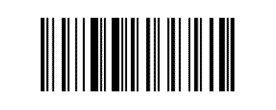Garis-garis hitam yang dibuat menurut kode tertentu, umumnya digunakan sebagai identifikasi terhadap suatu objek atau barang
Kode Batang. Sejenis kode yang mewakili data atau informasi tertentu (biasanya jenis dan harga barang seperti makanan dan buku). Kode berbentuk batangan balok dan berwarna hitam putih ini, mengandungi satu kumpulan kombinasi batang yang berlainan ukuran yang disusun sedemikian rupa. Kode ini dicetak di atas stiker atau di kotak bungkusan barang. Kode tersebut akan dibaca oleh alat pengimbas (Barcode reader) yang akan menterjemahkan kode ini kepada data/informasi yang mempunyai arti. Di supermarket, barcode reader ini biasanya digunakan oleh kasir dalam pencatatan transaksi oleh customer. Tidak ada satu standard dari kode batang ini, malahan terdapat bermacam-macam standard yang digunakan untuk berbagai keperluan, industri, maupun berdasarkan tempat digunakannya. Semenjak 1973, Uniform Product Code (UPC) diatur oleh Uniform Code Council, sebuah organisasi industri, yang menyediakan suatu standard bar code yang digunakan oleh toko-toko retail. Joe Woodland, merupakan penemu sistem barcode ini.
A barcode is an optical machine-readable representation of data. Originally, bar codes represented data in the widths (lines) and the spacings of parallel lines, and may be referred to as linear or 1D (1 dimensional) barcodes or symbologies. They also come in patterns of squares, dots, hexagons and other geometric patterns within images termed 2D (2 dimensional) matrix codes or symbologies. Although 2D systems use symbols other than bars, they are generally referred to as barcodes as well . Max Budack had the idea in 1880 but did not have the funds to proceed with his work.[citation needed]
The first use of barcodes was to label railroad cars, but they were not commercially successful until they were used to automate supermarket checkout systems, a task in which they have become almost universal. Their use has spread to many other roles as well, tasks that are generically referred to as Auto ID Data Capture (AIDC). Other systems are attempting to make inroads in the AIDC market, but the simplicity, universality and low cost of barcodes has limited the role of these other systems. It costs about US0.5¢ to implement a barcode compared to passive RFID which still costs about US$0.70 to US$1.30 per tag.[1]
Barcodes can be read by optical scanners called barcode readers, or scanned from an image by special software. In Japan, India & Europe most mobile phones have built-in scanning software for 2D codes, and Nokia in particular has this since 2005, similar software is expected to become available on smartphone (Apple) in 2015.

No comments:
Post a Comment